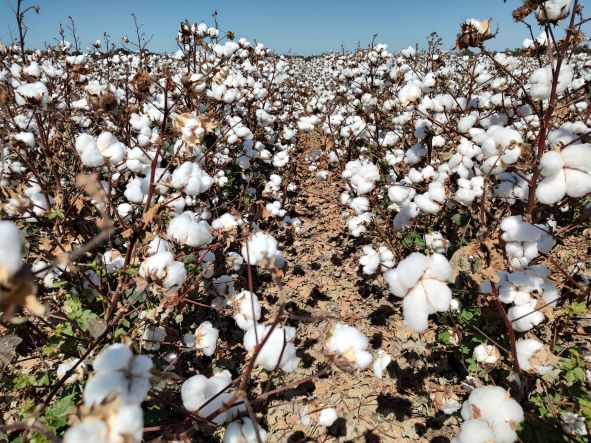Falling Production, Increased Demand
The USDA Foreign Agricultural Service’s Chinese Attaché Report says China’s already falling domestic production could drop another 30% in the 2009/10 marketing year. With mill demand starting to show signs of rebound, China’s imports could increase from 1.6 million metric tons (7.4 million bales) in the 2008/09 marketing year to 3 million metric tons (13.8 million bales) in 2009/10, an increase of 85%.
Based on those figures, Bloomberg.com reported in late April that U.S. cotton exports alone could surge by 51% to 7.4 million bales in 2009/10.
Does this signal that depressed world prices have hit bottom and a global recovery begins in 2010? Merchants and economists are encouraged but cautious.
Editor’s note: Some references below use metric tons. A metric ton is the equivalent of 4.2 480-pound bales.
Anthony Tancredi
Allenberg Cotton Co.
Cordova, Tennessee
There are many different perspectives on China’s import number for next year. Some claim only a nominal increase due to a later than expected rebound in textile health; some even higher than the 3 million metric ton figure because they view things stronger than data currently shows. For example, yarn production in March was the second highest in history, so things can’t be all that bad. So it’s all opinion at this stage.
Do I think the rebound could be that big? Yes, it’s possible, but I don’t think it’s there yet, and probably won’t be until the following year. I think it will be more like 2.5 million tons in imports for next year, knowing all that we know today. Part of the increase in import is coming from the decreased planted acreage expectations inside of China, and part from the fact that even in the poor textile climate, China is still a net deficit cotton producer versus its own demand. Recovery will be coming, but slower than people hope. Meanwhile China will be all about the pace and willingness of the government to release its large reserve stocks.
But going with the 3 million ton import figure, then it represents 53% of China’s imports, which is too high in a normal year.
Again, sticking with the Bloomberg numbers, this would be 7.3 million 480-pound bales, and would result in an export number north of 14 million, which in turn would require an area number for the U.S. slightly over 10 million if the market was to enjoy a non-frightening carry out number.
Dr. Gary Adams
National Cotton Council
Memphis, Tennessee
I don’t think the rebound will be that large. The Attaché Report seems optimistic for China’s mill use. In a recent outlook to the American Cotton Producers meeting, my estimates for China’s imports in 2009/10 were about 10.5 million bales – better than 2008/09, but not as optimistic as the Attaché Report. I should also point out that the Attaché Report numbers are not the official USDA estimates for China. It’s interesting that the Attaché Report is carrying much lower stocks for China than the official USDA numbers.
While I think China will increase imports in 2009/10 due to slightly better mill use and lower internal cotton production, the U.S. will also face stiff competition from Indian exports in the Chinese market. China could also be more aggressive with liquidating stocks and that would limit their imports.
If the Attaché estimates were correct, that certainly tightens the U.S. balance sheet. Even with my more conservative estimate of China’s imports, U.S. exports are large enough to cause a decline in stocks in the 2009 marketing year. Imports from the U.S. at the level of the Attaché Report would tighten the U.S. stock situation even further.
I don’t have any specific acreage estimates for 2010, but a tightening stocks situation should create a market where growers will take a hard look at bringing some acres back into cotton in 2010. Of course, corn and soybean prices will continue to be a wildcard in the acreage decisions.
Dr. Ernie Schroeder, Jr.
Jess Smith & Sons Cotton Co.
Bakersfield, California
In the 2008/09 season, Chinese imports of cotton dropped to just 7 million bales, from about 11 million bales in the 2006/07 and 2007/08 seasons. The U.S. Attaché has estimated that they will increase to almost 14 million bales in the 2009/10 season. The increase in demand is from a combination of reduced production, increased consumption and lower stocks.
A major factor for increased imports is the increasing need to allocate more land to food production than fiber within China. The Attaché estimates the Chinese crop to drop to 34 million bales in the 2009/10 season based on a 6% drop in acreage. Many surveys suggest that acreage may not reach these levels, with estimates of a 14-20% decline possible.
Chinese consumption fell from 51.5 million bales to 45.5 million bales in 2008/09. The forecast for 48.7 million bales in 2009/10 season shows a minimal rebound in demand. The recent Chinese stock building of industrial commodities suggests they anticipate their domestic economy will improve more quickly than other parts of the world and they are stocking up accordingly. The chance of further government stimulus within China may also lead to further improvement in their domestic economy and as a result increased demand for cotton.
Current estimates of the Chinese Supply and Demand situation forecasts ending stocks in the 2008/09 season at 19.7 million bales. While this may sound large, much of this has been purchased for the Government Reserve. The reserve is about 12.4 million bales. This would leave available stocks at just 7.3 million bales at the end of the season, or a 16% stocks-to-use ratio. It is no wonder why internal Chinese prices have been increasing steadily with these limited stocks. Clearly, in the next few months China will need to release new import quotas and perhaps also some of the reserve cotton. With a normal stocks-to-use ratio of free cotton around 33%, they may need over 7 million bales before the new crop.
As you look at the 2009/10 estimates, the Attaché is showing ending stocks dropping to 18.9 million bales, even if they import 13.8 million bales. The only way that imports are only 13.8 million bales is if they release all the reserve, which is considered unlikely.
The estimates released by the Attaché are for the 2009/10 season. The key consideration for U.S. 2010 cotton acreage will be prices. With world production forecast at up to 15 million bales less than consumption in the 2009 season, it would not be surprising to see prices rise to the level needed to increase world acreage in the 2010 season. An increase in Chinese imports could help improve the competitiveness of cotton relative to other commodities, but it may be too early to suggest that in 2010.









